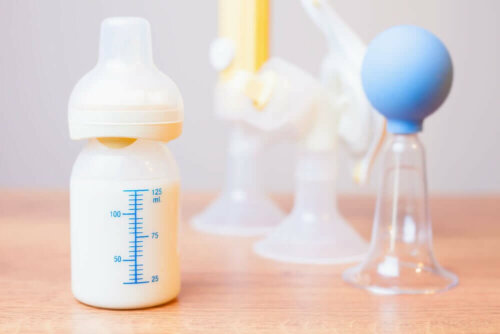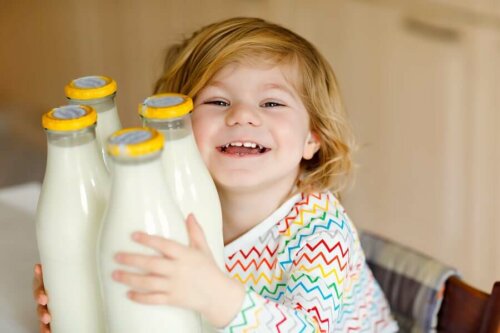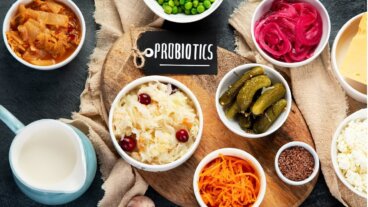What's the Healthiest Milk for Children?


Written and verified by the doctor Nelton Abdon Ramos Rojas
Milk has always been considered an essential food you should include in your diet; one that provides a great nutritional contribution. But, what’s the healthiest milk for children? Is it best to choose some specific kind or a specific brand?
During the first months of a baby’s life, there’s nothing better for them than what comes directly from their mother. By this, we mean that the best option at that age is breast milk. As babies grow, parents need to seek additional nutritional alternatives to help their growth and development.
There are many alternatives on the market. Generally, when you have a baby or a small child, we recommend you check with your pediatrician before you start giving them any kind of alternative. Not doing this could put their health at risk.
The majority of children’s milk contains essential nutrients like calcium and vitamin D. However, they can also contain many others; according to the brand and type of milk, the number of nutrients will vary.

Discover: Improve Your Digestion and Relieve Inflammation With This Papaya and Almond Milk Smoothie
Which is the best milk for children, whole or skim milk?
Choosing milk for children was a lot easier four decades ago. It was normal for babies to go directly from breast milk to whole milk. The only differences were their presentation: either powdered or liquid.
The diversified production allowed for the production of new foods with specific formulas for children. And so, companies began to create skimmed drinks, in the hope to reduce the amount of fat in milk.
Although adults have other kinds of needs, the children that drink whole milk usually get more vitamin D. It’s important to mention that this is without being affected by the high-fat content of the traditional product.
Alternatively, for babies and children that don’t suffer from lactose intolerance nor being overweight, specialists will usually recommend they drink whole (cow) milk.
Cow milk has more nutrients
Since cow milk is less processed, it’s one of the more complete drinks, from a nutritional point of view. It contains calcium, proteins, vitamin D, and vitamin B12. All of these nutrients promote good nutrition in children and infants.
Having a lot of vitamin D is important because it contributes to proper calcium absorption, which is beneficial for the child’s development.

Should you choose skim milk?
Specialists recommend that parents of overweight children should choose to include low-fat milk in the child’s diet. This allows them to receive all the benefits of this milk, without causing weight gain. In these cases, the main goal is nourishing the child while helping them to lose weight.
Babies with excess calcium (hypercalcemia) or who suffer from allergies or kidney stones should drink less concentrated formulas. Lactose-intolerant people should do the same. Of course, it’s important to consult a specialist whenever you consider a diet change.
However, semi-skimmed milk is a good choice for any of these cases. This type of milk has 1.8% fat and it has the essential nutrients children need.
Discover: Combat Hair Loss with this Aloe Vera and Coconut Milk Treatment
Other calcium-rich foods

There are other foods high in calcium: orange juice, spinach, rice, nuts, fish, eggs, among others. But, there’s one food in particular that children love and also contains this mineral: chocolate.
Other dairy products such as cheese and yogurt also have calcium. In short, it’s important to have a balanced diet and include high-quality foods in children’s diets.
Milk is very important for your child’s growth. Choosing the most appropriate type of milk is an important decision all parents should make based on their pediatrician’s advice.
All cited sources were thoroughly reviewed by our team to ensure their quality, reliability, currency, and validity. The bibliography of this article was considered reliable and of academic or scientific accuracy.
- FAO/WHO. (2011). Milk and Milk Products. CODEX Alimentarius. https://doi.org/10.1007/978-1-4615-1813-6_7
- Farkye, N. Y., & Shah, N. (2014). Milk Proteins. In Applied Food Protein Chemistry. https://doi.org/10.1002/9781118860588.ch16
- FAO. (2013). Dairy production and products. https://doi.org/10.1007/s00586-011-2126-6
- Galina, M. A., Palma, J. M., Pacheco, D., & Morales, R. (1995). Effect of goat milk, cow milk, cow milk replacer and partial substitution of the replacer mixture with whey on artificial feeding of female kids. Small Ruminant Research. https://doi.org/10.1016/0921-4488(95)00668-B
This text is provided for informational purposes only and does not replace consultation with a professional. If in doubt, consult your specialist.








